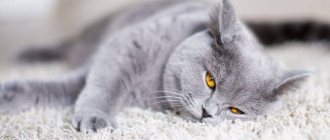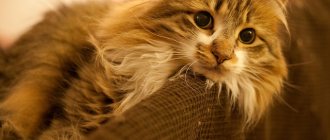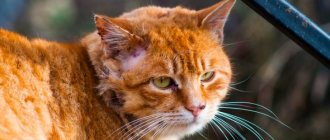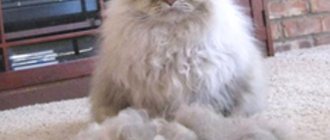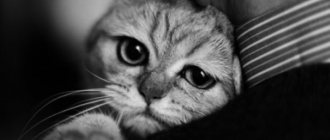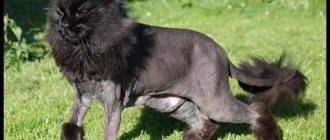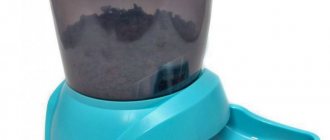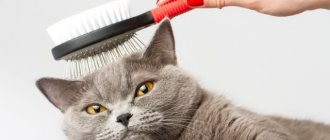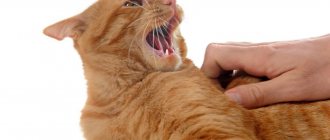Every owner of a domestic cat knows this unpleasant state: after removing a blissfully purring animal from your lap, you notice a layer of fur on your clothes, which takes a long time to clean off. And there’s no need to talk about the appearance of the plush chair chosen by the pet. The most annoying thing is that this problem is by no means limited to owners of long-haired breeds. All cats shed (with the exception of hairless sphinxes and left-handed cats). Yes, the problem of cat hair loss cannot be completely solved, but this does not mean that it should be ignored. Moreover, sometimes it is a signal: something is wrong with the cat.
Why and how cats shed
Shedding in cats is a natural, regular process of changing coat. Shedding in animals happens for different reasons and at different times.
Shedding is a common occurrence in cats.
Seasonal
In a normal situation, a cat sheds twice a year:
- the beginning of cold weather. The transition to the winter season is signaled by a decrease in daylight hours, a decrease in temperature, and this turns on protective mechanisms in animals. Cats quickly grow new fur to keep them warmer in cold weather.
- onset of heat. In summer, the hair grows lighter so that it does not get hot.
Cats who roam freely react the most to the change of season. Their body senses weather changes more strongly and reacts more sensitively.
Pets that are not allowed outside also shed, but regardless of natural conditions. Shedding occurs once or twice a year.
Seasonal molting lasts about a couple of weeks to two months. If the shedding continues, you should contact your veterinarian.
According to breed characteristics
In cats with long, thick fur, this process occurs much more noticeably.
Mustaches are divided into 4 types:
- long-haired;
- semi-longhaired;
- short-haired;
- hairless.
The shorter the coat and thinner the undercoat, the less problems with shedding.
Hypovitaminosis
Reason number 4 – vitamin deficiency. This reason most often concerns young, growing kittens, because during their growth period their body requires an increased diet containing not only nutrients, but also increased doses of microelements (calcium, magnesium, etc.) with a mandatory set of vitamins, without which these elements simply are not absorbed. And hair loss begins...
Hypovitaminosis in kittens is a very common phenomenon in kittens that have fallen into the hands of careless owners who are trying to feed a predator animal (and a cat is a predator!) with products of little benefit to it. The first organ that reacts sharply to hypovitaminosis is the coat. The kitten may remain sick and bald for the rest of its life, which, let’s be honest, will be very short.
These problems associated with molting (and not only!) can be avoided if you catch yourself in time and provide the younger generation with a decent diet and an additional course of vitamins.
© shutterstock
When do kittens start moulting?
Little kittens hardly shed; instead of fur they have baby fluff.
But caring for the fur of kittens should begin at a young age, as it will be much easier to accustom them to brushing.
However, caring for a kitten’s fur coat, and, in particular, brushing, must begin from an early age. It is much easier to train a small kitten to be groomed than an adult. Also, early brushing will help prepare them for their first shed.
It's easier to train a kitten to brush
Kittens begin to shed at about six months (5 – 8 months). Not only the fur changes, but also its color. When cats begin to shed for the first time, which can be up to 6 months, it is the most intense because the body is subject to a complex maturation process.
Allergy
The cause of excessive shedding in cats can also be an allergic reaction to unsuitable care products - shampoos, lotions, conditioners, hard brushes, too hot water when bathing or a hair dryer jet (allergy to mechanical effects on the skin).
© shutterstock
If cosmetics and care products are used incorrectly or inappropriately, dandruff and irritation appear on the scalp, and hair begins to fall out. Cats have much more sensitive and thinner skin than humans! Change your shampoo, be more careful with your slicker brush and hair dryer, buy cat vitamins “for fur” that help strengthen and nourish the skin and hair follicles. This will not only help stop your cat's shedding, but will also keep her healthy.
Allergies can manifest not only to household chemicals, but also to flowering plants, insect bites, dust, medications, food, etc. In this case, sneezing, saliva-and-tear-flow is not at all necessary, but scratching, dandruff and profuse hair loss are required.
Seeing a doctor is also mandatory! Only he, through testing, will be able to determine the allergen affecting the cat and prescribe the necessary medications.
Causes of severe shedding
The normal state of health of an animal during molting is if:
- Skin of normal color.
- The wool does not fall out in clumps, leaving no bald spots.
- The cat has a normal appetite and a healthy appearance.
- There is no unpleasant odor from the mouth or ears.
- body temperature is normal.
Hair loss is almost never the only symptom of any disease.
But sometimes the shedding becomes very strong.
Apartment molt
This type of shedding is common in pets. It is especially aggravated during the heating season, when the air in the apartment becomes very dry. You can use a humidifier to avoid excessive hair loss.
Apartment shedding is stronger during the heating season
Hormones
Unneutered cats who are not sexually active may suffer from hormonal imbalances. This greatly affects the condition of the pet’s skin.
Hormones can fluctuate after estrus, during pregnancy and after childbirth, just like in humans.
If you do not breed cats, then it is better to have surgery. If this is not possible, your doctor may recommend a course to avoid hormonal imbalances.
Stress
Cats have a very good nervous system. But even they are susceptible to stress under certain conditions:
- Change of habitual habitat.
- A trip in public transport, a long road.
- The appearance of a new animal in the house.
- Long-term loneliness.
- Change of habitual way of life (usually lack of affection, new prohibitions, etc.)
Cats shed a lot due to stress
Try to save your cat from unnecessary worries and isolate him from unusual situations. If the shedding goes away, then the problem is definitely due to stress.
Improper care and feeding
Owners should take very good care of their beloved pets. Feeding and care are the main things we need to provide them with. Care products must be strictly individual and suitable for the cat’s breed (shampoos, brushes, ointments).
The diet must be balanced; you cannot feed cats food from the table. Good animal feed contains all the necessary microelements and substances.
Hair loss also occurs due to dysbiosis after treatment with antibiotics. Intestinal function is disrupted.
Old age
As cats age, their body begins to work worse, their immune system weakens, causing their fur to become thin, dull, and fall out. This is a natural life cycle.
Cats lose fur as they age
Allergy
An allergy is a skin reaction, namely inflammation, redness, itching. This ailment occurs as a result of a change in the usual diet.
Allergies are usually accompanied not just by hair loss, but by the formation of bald patches.
In case of allergies, hair falls out due to damage to the skin.
A possible allergen should be excluded and the process of hair loss should be monitored.
Diseases and parasites
Severe hair loss is caused by a number of diseases, both skin and internal. This is already a pathology.
Skin diseases:
- Ringworm, fungal infections.
- Demodicosis (subcutaneous mites);
- Dermatitis (due to flea secretions, ectoparasites).
- Scabies (Notoedris cati mite).
- Eczema.
In case of allergies, hair falls out due to damage to the skin.
All of these diseases are characterized by clear lesions and are accompanied by irritation and fur loss.
Internal diseases include endocrine system disorders, including diabetes mellitus or neoplasms. In these cases, baldness is a secondary symptom and the primary cause must be dealt with.
Low-shedding breeds
There are two groups of cats that are least susceptible to shedding. These are hairless varieties and cats with a rex-type coat.
Don Sphynx
Good-natured and intelligent Donchas are an excellent example of a companion cat.
Story
The ancestor of the breed is the street cat Varvara, who was picked up in 1986 by Associate Professor of the Russian State Pedagogical Institute Elena Kovaleva.
Initially, the kitten was fluffy, but at 7–8 months it began to rapidly go bald. Examinations showed no health problems, and the animal was otherwise developing well. When Varvara grew up, she gave birth to two girls from a mating with a neighbor cat: the partially hairless Chita and Loskutok, covered with normal fur.
Chita was received by felinologist Irina Nemykina, who began breeding a new breed.
In 1997, the Donchak people were recognized by the WCF.
An interesting feature of sphinxes is their long, dexterous fingers with which they can grab objects.
Appearance
Donchak is a relatively large breed. The weight of females ranges from 3.5–5 kg, males – 5–7 kg. Height at withers 25–30 cm.
The WCF standard provides the following appearance:
- The head is wedge-shaped, the cheekbones and eyebrows are sharply defined. The forehead is flat, with many folds. The nose is straight, with a barely noticeable transition to the forehead. The muzzle is slightly rounded, with a pinch. The ears are large, set high, with rounded tips. The eyes are almond-shaped.
- The body is proportional, strong boned, muscular and at the same time elegant. Shoulders wider than croup. There are visible skin folds. The legs are long and slender. The hind limbs are slightly longer. The fingers are long and mobile. The tail is long, without bend.
- The skin is elastic, velvety, with folds, very hot - the body temperature of this breed reaches 40 °C.
- Any color is allowed.
Donchak combine strength and elegance
Based on the quantity and quality of wool, Donchak dogs are divided into the following types:
- Completely naked.
- Flock - there are microhairs up to 1 mm.
- Velor - hairs 2–4 mm.
- Brush - there are coarse hairs, the hair growth is pronounced. This type cannot receive titles at shows, but is actively used in breeding.
The animal may become overgrown or bald, and also change its coat type depending on hormonal changes and the season. Even the brushed type can become completely bald over time.
Sometimes kittens with normal straight hair appear in a litter, but they are rejected from breeding.
Video: everything about the Don Sphynx breed
Character
Don Sphynxes are very affectionate and peaceful pets. Breeders especially emphasize the lack of aggression in these animals.
They are not prone to ingratiation and prefer equal relationships, but they are strongly attached to their owners and are in dire need of human company, which is why they can be intrusive. At the same time, they sense the owner’s mood and can adapt to it.
At a young age they are very active and inquisitive; as they grow older, their activity becomes more moderate. They are easy to train and quickly learn the rules of behavior in the house.
They coexist peacefully with other animals. Some owners claim that Doncha dogs do not harm even birds and rodents, but you need to remember that there is still a risk in this case.
Donchaks can be trained to walk on a leash
Uncastrated males may strive for dominance. As a rule, they are less affectionate towards their owners.
Cats are more playful and have stronger bonds with people.
Yes, yes, a cat of this breed is the complete master of the house, the rest are like a free application and service staff. I cannot answer for all the numerous individuals; I will only tell you about my Koska. The cat was given to me not so long ago, 4 months ago, but I have known him almost since birth, that is, 7 years. From the very first days, Koska identified me as his mistress unconditionally. This means constant communication, jumping into arms, grabbing with paws, purring from all sides and an offended, perplexed look if I do not obey. The cat sincerely does not understand how it is possible not to take him in your arms at the first request or not let him sit on your knees. Cat petting around the clock, with short breaks for sleep and food, this borders on intrusiveness. But, perhaps, there are no more disadvantages.
Vera Golubeva
https://irecommend.ru/content/donskoi-sfinks-koshka-kotoraya-gulyaet-sama-po-sebe-net-neteto-koshka-kotoraya-gulyaet-po-te
Canadian Sphynx
This breed, despite its relative youth, is actively used to create unusual hairless hybrids.
Story
The history of the breed began with the birth of a hairless kitten in the Canadian city of Toronto, who was named Prune. After some time, the baby was bought by professional breeders. To consolidate the breed characteristics, they crossed Prun with his relatives, but the resulting kittens were excessively sickly and often died. After some time, the work was curtailed and the animals were sold. Two of them, a male and female, were purchased by the Mewsi-Kal nursery. The offspring obtained there were sent to Holland to the breeder Hugo Hernandez, where the main work began on consolidating the breed characteristics.
Later, two more bald girls were brought to the Dutch nursery from Toronto - believed to be undocumented descendants of Prune.
During the formation of the breed, Hugo Hernandez bred hairless females with Devon Rex dogs, and this proved successful.
Although most of the breeding work took place in Holland and the USA, these sphinxes are called Canadian in honor of the homeland of their first representatives
Meanwhile, several more animals with similar mutations were born in the USA, so work on creating the breed was carried out in parallel in several nurseries. To do this, they used the Dutch experience of crossing with Devon Rex.
At the moment, the breed is recognized by all major felinological organizations.
“Canadians” became the founders of a number of other hairless varieties: elves, dwelfs, bambinos. Like the original group, they do not cause problems with shedding.
Appearance
According to the CFA standard, the animal should look like this:
- The head is shaped like a modified wedge. The muzzle is slightly rounded. The nose is straight. The transition line from the cheekbones to the muzzle is clearly visible. The ears are large and wide at the base. The eyes are slightly slanted, wide in the middle, tapering towards the edge.
- The body is muscular, strong, with a wide chest. Males weigh 3.5–6 kg, females 2.5–4 kg. Height at the withers is from 15 to 25 cm. The hind limbs are longer than the forelimbs.
- The hair on the bridge of the nose should be normal. The animal may also have short hairs on the outer parts of the ears, paws, scrotum and tail. The rest of the body should be either completely hairless or covered with short down. The skin is folded.
- Colors allowed are solid, tabby, tortoiseshell, color point, as well as combinations with white.
Photo gallery: Canadian Sphynxes
Walking is allowed only under the supervision of the owners
There should be normal hair on the bridge of the Sphynx's nose. Kittens have especially many folds on the skin.
Tortoiseshell Sphynxes look very impressive, but this color is only allowed for cats. For “Canadians” several colors are allowed
Character
Canadian Sphynxes are a striking example of companions. They adore human company, strive to spend as much time as possible with their owners and willingly participate in all household chores. Often one owner is chosen. Loneliness is not tolerated well.
They are patient with children and sometimes even try to “educate” them in their own way. Usually friendly with strangers.
They are curious and willing to explore new places. They are intelligent, easy to train and can learn a number of commands. Balanced, little inclined to vindictiveness even after punishment.
They love to be the center of attention, including posing in front of a camera or camera.
They get along easily with other cats and non-aggressive dogs.
The disadvantages include the untidiness of some individuals when visiting the toilet.
It’s a rare occasion when he climbs under the blanket, then he lies down on the entire bed and pushes us out of our seats with his paws). You will also sleep as if you had a child - waking up 100,500 times a night because he is sad and wants to play or eat. He will wake you up by biting you on the legs, or just walk on you and he doesn’t care whether you like it or not, walking on your face is a common thing. You can’t do anything without him, he will be with you everywhere, just accept it. Even when I’m peeling onions, he sits next to me and.... CRYING =) and he won’t go anywhere without you) At the same time, he will help you peel potatoes, wash the floors, bath and toilet, and in general everything!!!
VeronikaVK
https://irecommend.ru/content/ne-znala-baba-gorya-kupila-baba-porosya100500-foto
Peterbald
The St. Petersburg Sphynx is a graceful type of hairless cat.
Story
The breed was bred purposefully - felinologists sought to obtain a hairless animal of a more graceful type than that of the Don and Canadian sphinxes. For the first mating, the Don Sphynx Afinogen Myth and the oriental cat Radma von Jaegerhof were used. One of their kittens, named Nocturne, became the founder of the breed - all Peterbalds have his genes.
Later, Siamese, Javanese and Balinese cats were used to consolidate oriental features. At the moment, breeding of Peterbalds and Donchak dogs is prohibited.
Oriental features are clearly visible in the appearance of Peterbalds.
The breed is recognized by TICA, WCF and SFF. Provisionally recognized by FIFe.
Appearance
The TICA standard assumes the following appearance:
- The head is long, in the shape of an inverted triangle. Cheekbones are high and flat. The nose is straight. The forehead is flat. The ears are large, pointed, wide at the base, slightly apart. The eyes are almond-shaped, slanted, and should be spaced at least one eye's width apart. The whisker pads are small.
- The body is long and graceful. Cats weigh on average from 3 to 3.5 kg, males - up to 5 kg. Body length from nose to tip of tail - 85–95 cm. Shoulders and hips of equal width. The limbs are long, with strong muscles. The tail is long.
- Any color is allowed.
Like Don Chaks, Peterbalds can have several types of coat.
The animal may be completely bald or have coat types such as flock, velor, brush or regular straight hairs. Brushes can participate in shows, but without receiving titles. Individuals with straight hair are not allowed into exhibitions, but in rare cases, if other indicators are very good, they are used for breeding.
Video: St. Petersburg Sphynx - description of the breed
Character
Peterebolds are playful, active, and strongly attached to their owner. They try to be nearby all the time, greet you at the door and accompany you to work, they really value a person’s attention. They love to sit on their hands. They prefer to spend the night in their master’s bed and generally try not to leave “their” person alone for a minute.
They are sociable, love to “talk” with their owners, and their meowing is expressive and quite loud. If something is not to their liking, they can shout loudly.
Curious, eager to explore new things. They learn commands well and can perform simple tricks.
They are trusting of guests and willingly make friends with them.
The hunting instinct is expressed. They get along well with other cats and non-aggressive dogs.
According to owners, this is a very clean breed. Most Peterbalds endure hygienic procedures such as bathing or ear cleaning patiently.
When you come home from work, it’s impossible to undress calmly, because the cat just jumps on you, climbs, climbs onto your shoulder and just hugs you. This position of a half-naked, hungry person from work and a happy cat can last from three to seven minutes. At the same time, an excited rumbling is heard throughout the room). Games...oh, it's a favorite pastime. There are toys that are dearest to a cat’s heart: a bud from a toy flower, plastic bottle caps and, of course, all those toys that can be stolen from a child. So here’s another surprising discovery for me: my cat is practically a dog. He brings a bud to my feet and asks me to throw it, then runs after it, brings it again, and so on in a circle.
mat-teresa
https://irecommend.ru/content/utrom-razbudyaka-dnem-skuchaka-vecherom-vstrechaka-obnimaka-postoyanno-vo-chto-igraka-vsegda
Devon Rex
Thanks to their original curly hair and intelligence, Devon Rex cats have gained popularity all over the world.
Story
The founder of the breed was a male named Kirli. In 1959, he was picked up off the street by a woman named Baryl Cox. In 1960, she learned about the existence of the Cornish Rex breed and assumed that Kirley was one of them. She wrote to felinologists and the cat was bought by Cornish breeder Brian Sterling Webb.
The first matings were unsuccessful - the curl gene in Kirly and the breeder’s cats turned out to be different. Nevertheless, through long selection work, the breed was formed.
The Devon Rex's unusual curly coat is the result of a natural genetic mutation.
At the moment, the Devon Rex is recognized by all leading felinological organizations.
Appearance
The CFA standard assumes the following appearance:
- The head is in the form of a modified wedge. Cheekbones are developed and protruding. The pinch is well expressed. Nose with stop. The ears are large, low set, with rounded tips.
- The muzzle is short. The mustache pads are convex. The eyes are large and widely spaced. The color must match the coat.
- The body is muscular, with a broad chest. Males weigh 3.6–4.5 kg, females 2.3–3.2 kg. The limbs are long and slender, with small paws. The tail is long and pointed.
- The coat is wavy, soft and elastic. Less thickness is allowed on the crown, neck, chest and abdomen.
- Any color is allowed.
Photo gallery: Devon Rex
Devon Rexes are interested in everything that happens in the house
Due to the sharply defined cheekbones, the muzzle of these cats looks a little “alien”
In childhood, these animals are especially playful and restless.
Devon Rex love heights
Character
Devon Rexes are smart, affectionate and affectionate pets. They strive for human company, willingly participate in all household chores and do not tolerate loneliness well. They prefer to sleep in the master's bed.
According to reviews from owners, representatives of this breed love to sit on their owner’s shoulders.
In childhood, they are energetic and active; with age, their temperament becomes more moderate. They love to climb to heights and watch from there what is happening in the apartment. Some people prefer to jump onto a person’s shoulders from cabinets or racks.
Many Devon Rex cats enjoy games that require not only physical activity, but also ingenuity: for example, puzzle feeders.
A number of commands are easy to learn.
They are prone to meowing quite loudly.
The Devonian is said to be a combination of cat, dog and monkey. Quite possibly. Well, from the outside it looks like a cat. Sometimes he behaves like a dog (if he wants to play, he follows you around the apartment and carries sticks, bones, balls and his other toys). Well, from the monkey - curiosity, the desire to climb somewhere and a strong tail (he, of course, does not weigh anything on them, but sometimes it seems that he sticks to it when he sits on his shoulder). The breed is smart. At least the previous animals did not turn on the TV when they were bored (often you come home and the TV is on), did not poke the phone buttons (likes to poke the base so that the answering machine would turn on, and once he got through to someone), did not turn on \turn off the light. Our cat, unfortunately, is very shy. Perhaps this is our fault (insidious laughter behind the scenes), or perhaps this is how the breed manifests itself. For example, he is afraid of a bag on the floor or shoes. In general, most often Elastanishka behaves like a capricious child, very skillfully urged by his mother, who always carries him in her arms and blows away specks of dust. In general, he really loves hugs. But most often he hugs his mother. Me - only when we move to my mother during her vacation - he climbs onto a chair, rises on his hind legs and reaches out to you - they say, carry me, slave)) In general, it’s interesting with him, his facial expressions are very rich. Now he makes a face, now he smiles playfully, now he looks offended, now he gets angry.
antoshuk.e
https://irecommend.ru/content/neobychnaya-poroda-dlya-nespokoinoi-zhizni
Cornish Rex
Curious and affectionate, Cornish Rexes are suitable for people who are willing to spend a lot of time with their pet.
Story
The breed arose as a result of an accidental mutation, when in 1950 a cat on a farm in Cornwall in England gave birth to a kitten with wavy hair. He was named Kalibanker and it was he who became the progenitor of the breed.
To consolidate the characteristics, the owner of the animal crossed Kalibanker with his mother and received two more curly-haired kittens. Further breeding used Siamese, Burmese and British Shorthair cats. At the moment, when the breed has already formed, mating with them is not allowed.
The Cornish Rex inherited refined grace from its “eastern” ancestors.
Since 1957, the main breeding work has been carried out in the USA.
There are three main branches of Rex: Devonian, Cornish, and also the German Rex, which formed a little later. In addition, there are young and experimental cat breeds with wavy hair.
The breed is recognized by all major organizations. The CFA and TICA standards are slightly different from the FIFe and WCF standards.
Appearance
According to the CFA standard, Cornish Rex dogs should look like this:
- The head is small, egg-shaped, about a third longer than wide. The forehead is rounded. The length of the nose should be equal to 1/3 of the length of the head. High cheekbones. The fashion is rounded, slightly tapering towards the end. The ears are large, wide at the base, and set high. The eyes are oval.
- Body small or medium. The weight of males reaches 4.5 kg, females - up to 3 kg. The average height at the withers is 23–27 cm. The thighs are muscular, but proportional to the rest of the body. The back forms an arch, especially noticeable when the animal is sleeping. The limbs are long and slender, with small paws.
- The coat is short, soft, relatively dense, without guard hairs. It represents “waves” that fit tightly to the body, the size of which can fluctuate.
Long slender limbs are an important feature of the breed
The standard allows for a large number of colors. The most common are tabby, calico, tortoiseshell, smoke, solid black, red and blue.
Video: description of the Cornish Rex breed
Character
Cornishes are active and cheerful companion cats. They form strong bonds with their owners and prefer to spend time in human company, usually choosing one owner. They strive to participate in his affairs, study and sniff the things he holds in his hands.
At the same time, they are very “intelligent”, easily learn the rules of behavior in the house, and are not inclined to steal food or spoil things.
Like their relatives, the Devon Rex, Cornish dogs love to sit on their owner's shoulders.
Offended by punishment, they can ignore the owner for a while or take revenge on him, but they are not prone to long-term rancor.
They quickly learn the rules of behavior in the house. They are smart and quick-witted, but at the same time very willful, so training can be difficult.
They are fearless and curious, adapt quite well to new conditions, and do not experience fear of unfamiliar animals. They love to explore new things and check packages brought from the store.
They are playful and active, and their love of ball games continues into old age.
Some breeders consider this breed to be the least allergenic: it practically does not shed, and there are no secretions on the skin of the Cornish Rex that provoke an allergy to Sphynxes.
Tasya’s favorite greeting is a loud “Meow.” We also love to lick the mistress’s forehead and nose, and curl up in a ball somewhere on the neck or legs. Are you uncomfortable?! The Cornishes don’t care about this; no one can hide from their love, be it the owner, the courier or the postman. Nevertheless, my cat has a character: now she spends most of her time sitting on the computer system unit, battery or refrigerator. If she doesn’t want to sit on your arms, but is forced to, you have to listen to a long and drawn-out moo - the resemblance to a cow is 99.9%) The vocal range of the Cornish Rex is much wider than that of ordinary cats. They are very talkative and love company - almost every Cornish owner knows this. Before you make a curly-haired friend, think: won’t such excessive attention and nightingale trills bother you?) Will you get tired of constant company? This is by no means a sofa cushion: these are real electric brooms. And they love to rush around both at 2 am and at 5 am. There is no place in the house where the Cornish Rex cannot get into. The tallest cabinet, refrigerator or shelf somewhere on the ceiling is not an obstacle, but just a quest that the cat will happily complete and climb to places you can’t even imagine. Be prepared to see a small eared muzzle looking down at you from somewhere and watching)
BeLLatris
https://irecommend.ru/content/kakoi-prostite-taison-u-vas-zhe-devochka-istoriya-moego-dvupologo-kornish-reksa-foto-na-razn
Ways to reduce shedding
It is impossible to get rid of natural shedding. Only serious illnesses require drastic interventions. And in normal times, we can only slightly reduce hair loss.
Vitamin complexes
Supplements reduce the amount of hair loss. Be sure to consult with your veterinarian about which vitamins are right for your pet.
Vitamins help against hair loss
Along with the supplements, you can give yolk (if you are not allergic) and sprouted grass.
Sprouted grass is useful in combination with vitamins
Buy a special paste for removing hairballs from the body of cats.
Special feed
A balanced diet is very important during such a period.
To ensure that the fur is always beautiful and healthy, and molting is not a severe torment, the animal’s food must contain: biotin (vitamin B7, deficiency leads to inflammation in the hair follicles. Acute biotin deficiency can lead to baldness) taurine, sulfur (enhances the effect of biotin ), vitamins B6, B2, B5, iodine, calcium, phosphorus, omega-3, omega-6.
Cat food is rich in essential nutrients
If the cat's diet consists of regular foods, then biotin and vitamin B6 must be present, which are found in beef, pork, chicken yolk, salmon, poultry, cheese, carrots, and buckwheat. But keep in mind that cats may be allergic to “human” food.
Dry food must be of high quality, at least super premium. They have everything you need to feed your pet.
There are two types of food recommended for consumption during shedding:
- Food for healthy skin and coat.
- Food for removing hair from the stomach.
Bathing and brushing
During washing and combing immediately after bathing, a very large amount of dead hair is removed.
More fur is combed after bathing
For cats with short fur, it is enough to brush them a couple of times a week with a regular comb. For fluffy, long-haired breeds, you will most likely have to take a Furminator. This is a professional device with very fine teeth.
Cats with long and thick hair are best combed with a furminator.
Why is it important to remove dead hair?
Villi that have already fallen out but are not removed from the cat’s body can cause irritation and itching on the animal’s skin. It actively licks off excess fur and tries to remove it with its paws.
This can be dangerous because when hairballs get into the stomach, gastrointestinal upset and intestinal obstruction begin.
Hair getting into the stomach leads to intestinal disorders and causes nausea
With its paws, a cat can scratch itself, which serves as a breeding ground for infections that cause skin diseases.
Wool flying around the house can cause allergies in allergy sufferers living in the house, especially in the spring.
How to quickly get rid of fur during shedding in an apartment
A powerful vacuum cleaner with special attachments for collecting fluff and hair is the only effective tool with an almost instant effect. Thomas offers several such solutions for pet owners:
- DryBox Amfibia Pet,
- DryBox+AquaBox Cat & Dog,
- Perfect Air Animal Pure,
- Vestfalia XT,
- Pet&Family,
- Cycloon Hybrid Pet & Friends, etc.
A vacuum cleaner that picks up pet hair should do so on all surfaces! Therefore, Thomas vacuum cleaners are able to clean fluff and hairs from the pile of even the thickest carpets, from upholstered furniture, as well as from smooth surfaces and fabrics. An additional bonus: cleaning the air with an aquafilter and eliminating unpleasant odors that often appear in homes where there are animals.
Tired of cleaning carpets and furniture every day with tape and gloves, owners of furry pets sooner or later decide to purchase a good vacuum cleaner. So why waste time and effort when you can enjoy a clean home today?
We hope that our tips for cleaning cat and dog hair in your apartment will be valuable to you and will help you solve such a pressing spring problem.
Source: article from the site https://thomas.info/press-and-media/vesennyaya-linka-u-sobak-i-koshek.html
